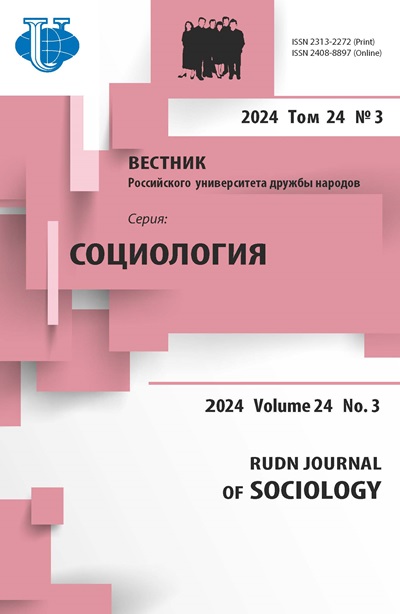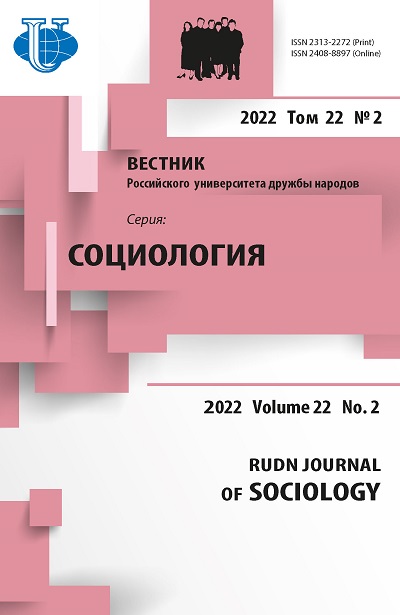Невербальные признаки образа личности: коммуникативные значения выражений лица
- Авторы: Шарков Ф.И.1,2, Силкин В.В.2, Киреева О.Ф.2
-
Учреждения:
- Московский государственный институт международных отношений
- Российская академия народного хозяйства и государственной службы при Президенте Российской Федерации
- Выпуск: Том 22, № 2 (2022)
- Страницы: 387-403
- Раздел: Социологический лекторий
- URL: https://journals.rudn.ru/sociology/article/view/31351
- DOI: https://doi.org/10.22363/2313-2272-2022-22-2-387-403
Цитировать
Полный текст
Аннотация
Существует множество свидетельств, что большинство людей вполне способны распознавать эмоции по лицу. Какую информацию обычно передает выражение лица? Могут ли проявляться эмоции без изменения выражения лица? Могут ли на лице отражаться эмоциональные признаки при отсутствии соответствующего эмоционального состояния человека? Существуют ли индивидуальные отличительные выражения эмоций на лице? На эти вопросы авторы стараются ответить в статье. Анализ результатов исследований различных аспектов невербальной коммуникации показывает наличие как сходств, так и различий в проявлениях невербального поведения. Считается, что сходства наиболее очевидны, когда анализ проводится на уровне индивида и основное внимание уделяется объективным, формальным свойствам поведения; различия с большей вероятностью обнаруживаются, когда анализ проводится на уровне отношений между индивидами, т.е. акцент делается на межличностном значении поведения. Несмотря на то, что они отличаются почти во всех других отношениях, большинство методов измерения выражений лица сосредоточены на том, что видно, что исследователь может различить, когда видит движение лица. Как и все базовые исследования коммуникативного процесса, проксемика больше связана с как, чем почему, и со структурой, нежели с содержанием. Статья фокусируется на вопросе, отражает ли невербальное поведение культурные сходства и различия. Учет уровней анализа позволяет наблюдать как культурную однородность, так и разнообразие, присущее большинству актов невербального поведения. В статье рассмотрены данные лабораторных экспериментов, оценивающих взаимосвязи между эмоциями и выражениями лица у взрослых. В последние десятилетия исследования невербальной коммуникации начали смещаться от описания того, что делают разные люди, к более систематическому анализу контекстуальных аспектов невербального поведения, поскольку межкультурные недопонимания часто бывают следствием незнания элементарных основ языка тела, в частности физиогномики. Американский антрополог, один из основателей кинесики, Р. Бердвистел считал, что язык тела большей частью определяется культурной средой, а не универсальными генетическими программами, и в статье разбираются работы Бердвистела, в частности, часто критикуемые его идеи.
Об авторах
Феликс Изосимович Шарков
Московский государственный институт международных отношений; Российская академия народного хозяйства и государственной службы при Президенте Российской Федерации
Email: sharkov_felix@mail.ru
доктор социологических наук, профессор кафедры социологии Московского государственного института международных отношений (университета) Министерства иностранных дел Российской Федерации; заведующий кафедрой общественных связей и медиаполитики факультета журналистики Института государственной службы и управления Российской академии народного хозяйства и государственной службы при Президенте Российской Федерации
просп. Вернадского, 76, Москва, 119454, Россия; просп. Вернадского, 84, Москва, 119606, РоссияВладимир Владимирович Силкин
Российская академия народного хозяйства и государственной службы при Президенте Российской Федерации
Email: vv.silkin@igsu.ru
доктор политических наук, декан факультета журналистики Института государственной службы и управления
просп. Вернадского, 84, Москва, 119606, РоссияОльга Феликсовна Киреева
Российская академия народного хозяйства и государственной службы при Президенте Российской Федерации
Автор, ответственный за переписку.
Email: kirolga08@list.ru
кандидат социологических наук, доцент кафедры информационных технологий факультета журналистики Института государственной службы и управления
просп. Вернадского, 84, Москва, 119606, РоссияСписок литературы
- Bavelas J., Gerwing J., Healing S. Including facial gestures in gesture-speech ensembles. From Gesture in Conversation to Visible Action as Utterance: Essays in Honor of Adam Kendon. John Benjamins Publishing Company; 2014.
- Bavelas J.B., Black A., Lemery C.R., Mullet J. “I show how you feel”: Motor mimicry as a communicative act. Journal of Personality and Social Psychology. 1986; 50.
- Birdwhistell R.L., Goffman E., Hymes D. Kinesics and context: Essays on body motion communication. Conduct and Communication Series, no 2, ed. by E. Goffman, D. Hymes. Philadelphia; 1970.
- Bonanno G., Keltner D. The coherence of emotion systems: Comparing ‘online’ measures of appraisal and facial expressions, and self-report. URL: https://www.semanticscholar.org/ paper/Coherence-between-Emotion-and-Facial-Expression%3A-Reisenzein-Studtmann/9595 34c2a593fc7053badfb037d0252f5557141e.
- Brannigan C.R., Humphries D.A. Human non-verbal behavior, a means of communication. N. Blurton Jones (Ed.). Ethological Studies of Child Behavior. London; 1972.
- Calvo M.G., Gutiérrez-García A., Fernández-Martín A., Nummenmaa L. Recognition of facial expressions of emotion is related to their frequency in everyday life. Journal of Nonverbal Behavior. 2014; 38 (4).
- Camras L.A. Facial expressions across the lifespan. V. LoBue, K. Perez-Edgar, K. Buss (Eds.). Handbook of Emotional Development. Cham; 2019.
- Carpenter J.P., Garcia J.R., Lum J.K. Dopamine receptor genes predict risk preferences, time preferences, and related economic choices. Journal of Risk and Uncertainty. 2011; 42.
- Carré J.M., McCormick C.M., Mondloch C.J. Facial structure is a reliable cue of aggressive behavior: Case report. 2009. URL: https://doi.org/10.1111/j.1467-9280.2009.02423.x.
- D’agostino T.A., Bylund C.L. Non-verbal accommodation in health care communication. Health Communication. 2014; 29 (6).
- Darwin C.R. The Expression of the Emotions in Man and Animals. London; 1872.
- Ekman P. Darwin’s contributions to our understanding of emotional expressions. Philosophical Transactions of the Royal Society B: Biological Sciences. 2009; 364.
- Ekman P., Friesen W.V. A New Pan-Cultural Facial Expression of Emotion. San Francisco; 1986.
- Ekman P., Friesen W.V., Ancoli S. Facial signs of emotional experience. Journal of Consulting and Clinical Psychology. 1980; 56.
- Ekman P., Sorenson E.R., Friesen W.V. Pan-cultural elements in facial displays of emotions. Science. 1969; 164.
- Fernández-Dols J., Crivelli C. Recognition of Facial Expressions: Past, Present, and Future Challenges. 2015. URL: https://www.semanticscholar.org/paper/Recognition-of-FacialExpressions%3A-Past%2C-Present%2C-Fern%C3%A1ndez-Dols-Crivelli/4b90956e738cca 9cd0a713b034282b9a73947d0c.
- Fernández-Dols J.-M., Crivelli C. Emotion and expression: Naturalistic studies. Spain Emotion Review. 2013; 5 (1).
- Fernández-Dols J.-M., Crivelli C. Naturalistic Studies. Emotion and Expression. Emotion Review. 2013; 5 (1).
- Fernández-Dols J.M., Ruiz-Belda M.A. The psychology of facial expression. Journal of Personality and Social Psychology. 1997; 2.
- Fernández-Dols J.M., Sánchez F., Carrera P., Ruiz-Belda M.A. Are spontaneous expressions and emotions linked? An experimental test of coherence.. A default mode of brain function. Proceedings of the National Academy of Sciences. 1997; 98.
- Foley G.N., Gentile J.P. Non-verbal communication in psychotherapy. Psychiatry. 2010; 7 (6).
- Fridlund A.J. The new ethology of human facial expressions. J.A. Russell, J.M. FernandezDols (Eds.). The Psychology of Facial Expression. Oxford; 1997.
- Fridlund A.J. The sociality of solitary smiles: Effects of an implicit audience. Journal of Personality and Social Psychology. 1991; 60: 229-240.
- Friedlund A.J. Human Facial Expression. An Evolutionary View. New York; 1994.
- Geniole S.N., McCormick C.M. Facing our ancestors: Judgements of aggression are consistent and related to the facial width-to-height ratio in men irrespective of beards. Evolution and Human Behavior. 2015; 36.
- Godinho R.M., Spikins P., O’Higgins P. Supraorbital morphology and social dynamics in human evolution. Nature Ecology and Evolution. 2018; 2.
- Hall E., Birdwhistell R. Proxemics [and comments and replies]. Current Anthropology. 1968; 9 (2/3).
- Hall E.T. The Silent Language. Garden City; 1959.
- Haselhuhn M.P., Wong E.M. Bad to the bone: Facial structure predicts unethical behavior. Proceedings of the Royal Society B: Biological Sciences. 2012; 279.
- Hu S. et al. Signatures of personality on dense 3D facial images. Scientific Reports. 2017; 73 (7).
- Hurrelmann K. Human Development and Health. New York; 1989.
- Hurrelmann K. Social Structure and Personality Development. New York; 1988 (2009).
- Hurrelmann K., Bauer U. Socialization during the Life Course. London - New York; 2018.
- Index fWHR for the personality face and character. URL: https://proprofiling.com/fwhr.
- Izard C. Innate and universal facial expressions: Evidence from developmental and crosscultural research. 1994. URL: https://www.semanticscholar.org/paper/Brief-Report-Thecoherence-of-emotion-systems%3A-of-Bonanno-Keltner/2869314ec7ffc32e509e6abdcdbed5 b8caa559f3?sort=relevance&citedPapersSort=relevance&citedPapersLimit=10&citedPapers Offset=10.
- Izard C., Ekman P. Psychology 2040A/B Study Guide; 2018.
- Jakobs E., Manstead A., Fischer A. 2001. Social context effects on facial activity in a negative emotional setting. URL: https://www.semanticscholar.org/paper/Coherence-betweenEmotion-and-Facial-Expression%3A-Reisenzein-Studtmann/959534c2a593fc7053badfb037 d0252f5557141e.
- Jiang J., Borowiak K., Tudge L., Otto C., von Kriegstein K. Neural mechanisms of eye contact when listening to another person talking. Social Cognitive and Affective Neuroscience. 2017; 12 (2).
- Jones S., Collins K., Hong H. An audience. effect on smile production in ten-month-old infants. Psychological Science. 1991; 2.
- Junior J.C.S.J. et al. First impressions: A survey on computer vision-based apparent personality trait analysis. 2018. URL: https://www.semanticscholar.org/paper/First-Impressions%3A-ASurvey-on-Computer-Apparent-Jacques-G%C3%BC%C3%A7l%C3%BCt%C3%BCrk/6c96 4e59bdac6b8044993ca96b47a9a0addedfb8.
- Kramer R.S.S., King J.E., Ward R. Identifying personality from the static, nonexpressive face in humans and chimpanzees: Evidence of a shared system for signaling personality. Evolution and Human Behavior. 2011; 32 (3).
- Kraut R., Johnston R. Social and emotional messages of smiling: An ethological approach. 1979. URL: https://www.semanticscholar.org/paper/Social-and-emotional-messages-ofsmiling%3A-An-Kraut-Johnston/bad0fb1225b8e4b98ffbb89ca45488a9aa5fd4a5.
- Krumhuber E.G., Hyniewska S., Orlowska A.B. Contextual effects on smile perception and recognition memory. 2021. URL: 10.1007/s12144-021-01910-5 2021.
- Lewis G.J., Lefevre C.E., Bates T. Facial width-to-height ratio predicts achievement drive in US presidents. Personality and Individual Differences. 2012; 52.
- Livesley W.J., Jang K.L., Vernon P.A. Phenotypic and genetic structure of traits delineating personality disorder. Archives of General Psychiatry. 1998; 55 (10).
- Marchak F.M. Detecting false intent using eye blink measures. Frontiers in Psychology. 2013; 4.
- Namba Sh., Kabir R., Miyatani M., Nakao T. Spontaneous facial expressions reveal new action units for the sad experiences. Journal of Nonverbal Behavior. 2017: 41.
- Namba S., Kabir R.S., Miyatani M., Nakao T. Dynamic displays enhance the ability to discriminate genuine and posed facial expressions of emotion. Frontiers in Psychology. 2018; 9.
- Nelson N.L., Mondloc C. Adults’ and children’s perception of facial expressions is influenced by body postures even for dynamic stimuli. Visual Cognition. 2017; 25 (4-6).
- Pound N., Penton-Voak I.S., Brown W.M. Facial symmetry is positively associated with selfreported extraversion. Personality and Individual Differences. 2007; 43.
- Reisenzein R., Studtmann M., Horstmann G. Coherence between emotion and facial expression: Evidence from laboratory experiments. Emotion Review. 2013; 5 (1).
- Russell J.A. Is there universal recognition of emotion from facial expressions? A review of the cross-cultural studies. Psychological Bulletin. 1994; 115 (1).
- Sato W., Hyniewska S., Minemoto K., Yoshikawa S. Facial expressions of basic emotions in Japanese laypeople. Frontiers in Psychology. 2019; 10.
- Sharkov F.I. Communicology. Encyclopedic Dictionary-Reference Book. Moscow; 2009.
- Sharkov F.I. Management without Words Manual. Non-Verbal Means of the Manager. Cheboksary; 1998.
- Shevlin M., Walker S., Davies M.N.O., Banyard P., Lewis C.A. Can you judge a book by its cover? Evidence of self-stranger agreement on personality at zero acquaintance. Personality and Individual Differences. 2003; 35 (6).
- Todorov A., Loehr V., Oosterhof N.N. The obligatory nature of holistic processing of faces in social judgments. Perception. 2010; 39 (4).
- Valentine K.A., Li N.P., Penke L., Perrett D.I. Judging a man by the width of his face: The role of facial ratios and dominance in mate choice at speed-dating events. Psychological Science. 2014; 25.
- Van Belle G., De Graef P., Verfaillie K., Busigny T., Rossion B. Whole not hole: Expert face recognition requires holistic perception. Neuropsychologia. 2010; 48 (9).
- Wang Y., Kosinski M. Deep neural networks are more accurate than humans at detecting sexual orientation from facial images. Journal of Personality and Social Psychology. 2018; 114.
- Welker K.M., Goetz S.M.M., Carré J.M. Perceived and experimentally manipulated status moderates the relationship between facial structure and risk-taking. Evolution and Human Behavior. 2015; 36 (6).
- Young A.W., Hellawell D., Hay D.C. Configurational information in face perception. Perception. 2013; 42 (11).
- Zebrowitz L.A., Collins M.A., Dutta R. The relationship between appearance and personality across the life span. Personality and Social Psychology Bulletin. 1998; 24.














